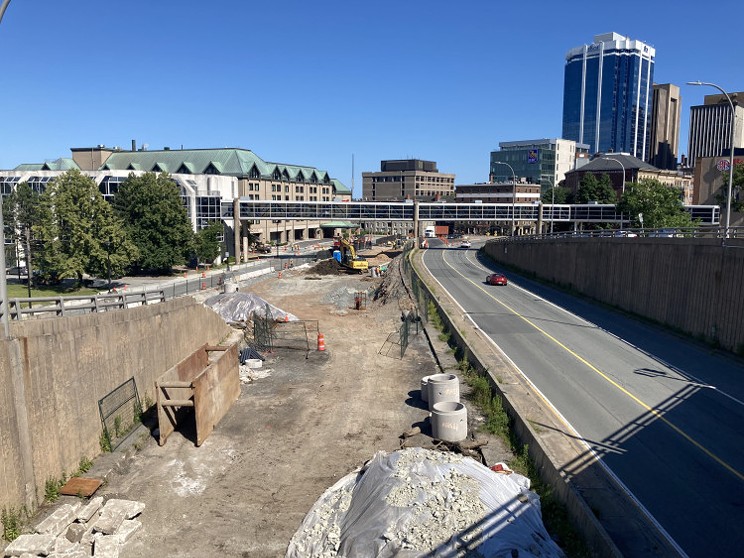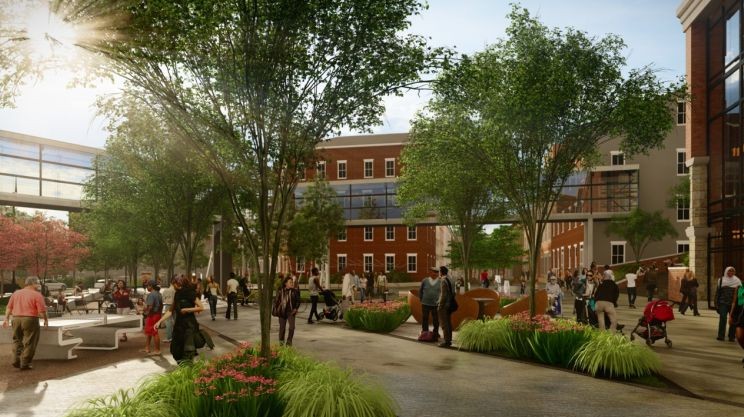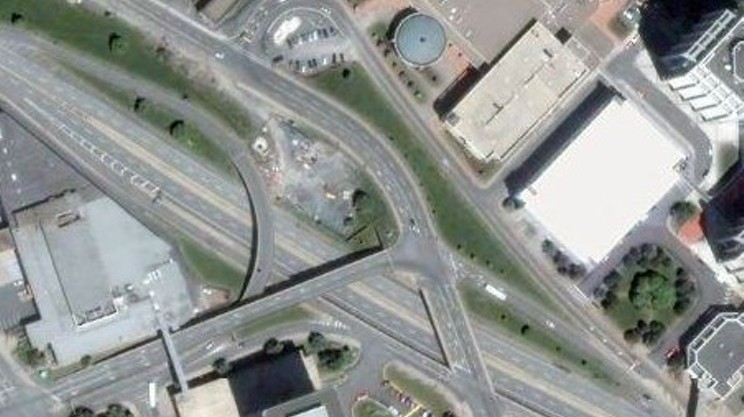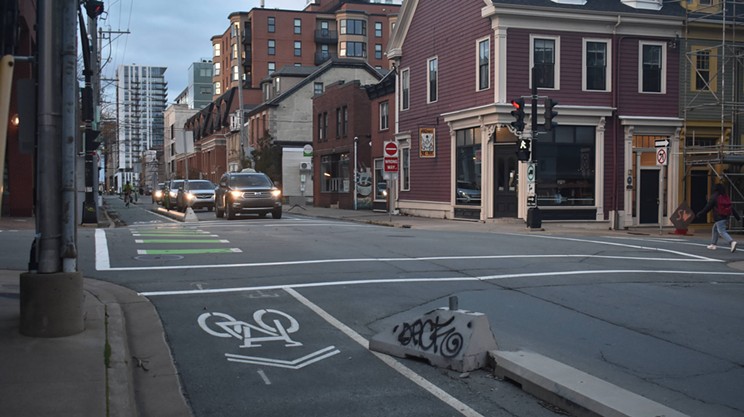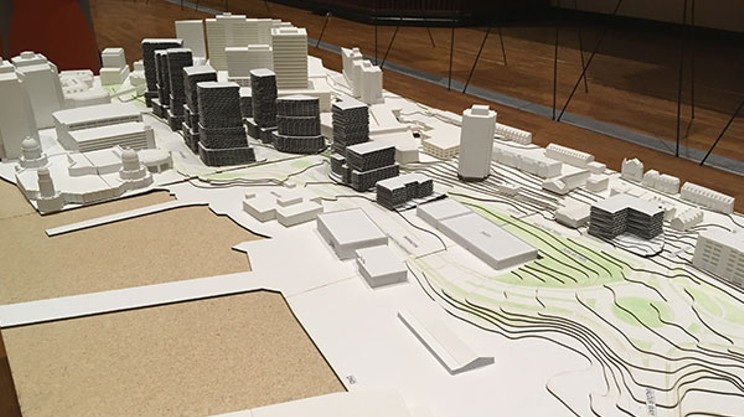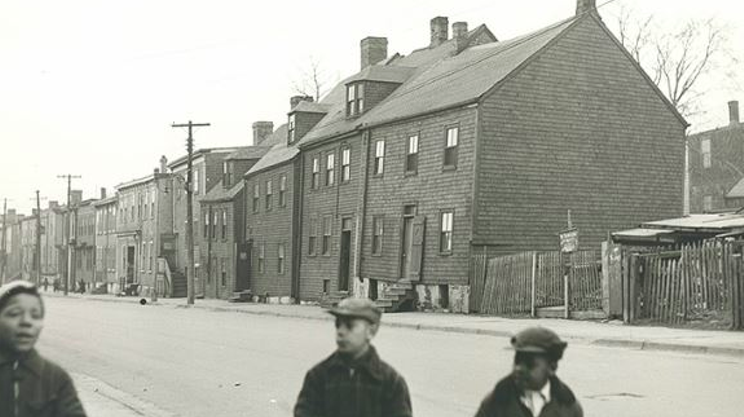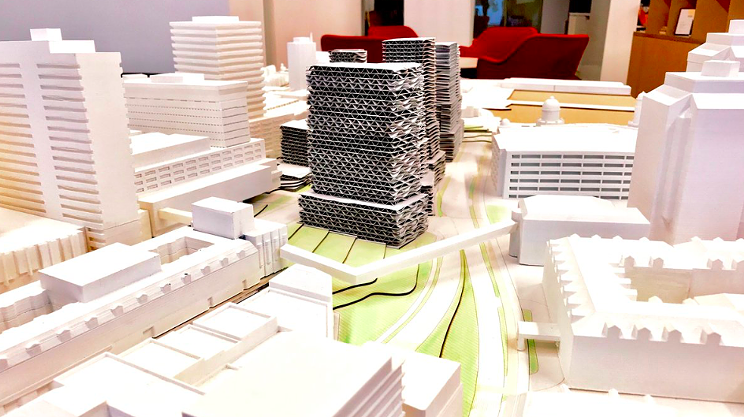It might be hard to believe when staring at the mound of rubble along Barrington Street north of Cogswell, but Halifax is one day away from one of its first key milestones in a landmark downtown redevelopment effort.
Road crews are nearly finished work on a detour that will last 18 months as developers clear land for the HRM’s vaunted Cogswell District project: A $122.6-million plan to raze the former Cogswell Interchange and replace it with a 16-acre neighbourhood, complete with an active transportation network, park space and room to house 2,500 people.
It’s been a long time coming for Cogswell. Talk of demolishing the quasi-highway hellscape and starting anew has been going on for so long in Halifax that, were it a person, it’d be downing sloppy drinks at The Dome and getting lectured for its late-night pizza runs by now.
Halifax mayor Mike Savage has called it the “largest, most ambitious city-building project” in the region’s history—one that will bridge the downtown, the north end and the waterfront while adding “much-needed housing” and amenities that “reflect public input gathered over the last number of years.” The new district will also add more than 500 trees, Savage told those gathered at the project’s Nov. 2, 2021 launch. The plan includes four parks, multi-use paths and a renewable energy system that will convert wastewater into heat. It’s expected to be finished by 2026.
It’s a plan that HRM’s chief administrative officer, Jacques Dubé, believes will “transform” the Cogswell Interchange from an “underutilized piece of road infrastructure” into a “new and vibrant urban neighbourhood in the heart of downtown Halifax.”
It also comes with weighty expectations—not just from Halifax’s council, but from those who’ve been waiting for the HRM to mend the scar tissue the former interchange left behind.
How we got here
It takes looking back at the postwar 1950s and ’60s to understand the quagmire Halifax created with the abandoned Cogswell Interchange—and what council is looking to fix today. Halifax’s suburbs were growing. When the Macdonald Bridge opened in 1955, it brought a new wave of commuter traffic (and, in turn, congestion) into Halifax’s downtown.
Council thought the best thing to do was to build a perimeter highway that would run along the waterfront from Fairview to South Street and, as Sharon Murray writes for Historic Nova Scotia, provide “better traffic flow” through the peninsula. (For a time, there were plans of a possible southern harbour bridge that would have linked up, roughly speaking, with the end of Inglis Street.)
The Cogswell Interchange was the first piece of Halifax’s Harbour Drive highway plan. It was also the only part ever built.
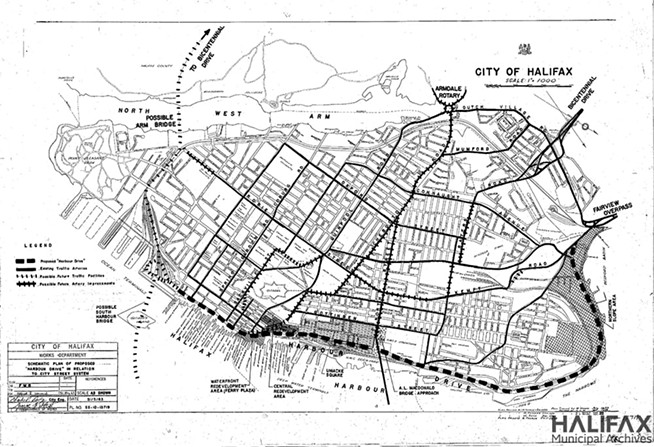
Credit public protests in the late 1960s with turning the tide of opinion against Harbour Drive. By 1968, construction of the Cogswell Interchange had displaced hundreds of Haligonians—many of whom were Black—from their homes along Upper Water and Barrington streets. Further project work was threatening Halifax’s historic waterfront properties. That didn’t sit well with residents.
“I think it would be a crime to demolish these [buildings],” one petitioner wrote in June 1969, after council met to discuss tearing down the historic properties.
“Why pull down a lucrative tourist attraction which integrated into the downtown development would serve to attract even more people there—especially those free-spending tourists?” one letter-writer from Halifax’s Jollimore neighbourhood wrote to the mayor and council on June 24, 1969. “I want my city to be an interesting, stimulating, worthwhile place to live in—not merely a network of perfectly aligned superhighways.”
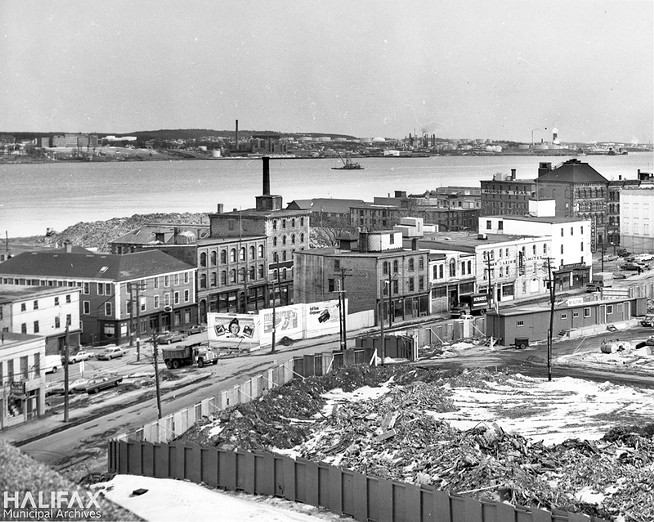
The campaigns worked. In 1970, council abandoned its plans for Harbour Drive. It would be nearly 30 more years before Halifax leaders discussed plans for what would come next—and another quarter-century before any such plans came to fruition.
The Cogswell District is delayed and $27M over budget
It was 2018 when Halifax compiled its list of potential companies to contract for an eventual Cogswell redevelopment project. The HRM was expecting to issue a project tender by 2020, the CBC reports—until the COVID-19 pandemic set things back.
Council had two bids to consider by August 2021. Bedford’s Dexter Construction Company Ltd. estimated it could handle the tear-down and construction of the Cogswell District for $95.6 million after taxes, but excluding contingencies and other costs (fees, permits and the like). Halifax’s Miller Paving Ltd. figured it could do the work for $103.9 million.
Both bids were higher than the $53.5 million council had earmarked for construction (and $95.2 million, after contingencies) in September 2020. With all costs included, Dexter Construction’s bid—which council preferred—came in $27 million higher than staff had anticipated.
In a Sept. 14, 2021 report to council, CAO Dubé noted that inflation and “higher construction costs since the time of the original project estimate” were to blame for the disparity, and conceded that Dexter’s bid reflected “fair market value.” Cutting costs wouldn’t be easy, either—since, as Dubé told council, the “vast majority” of the project’s costs were for “hard infrastructure” (things like roads and utilities) which “cannot be substantially reduced even if the design was reconsidered.”
By the time Halifax held its project announcement in November 2021, mayor Savage assured those gathered that “much of” the project’s expenses would be recovered through the eventual sale of real estate and property taxes. Cost-sharing with Halifax Water, Bell Aliant, Heritage Gas and Nova Scotia Power would also help to offset the cost—though those amounts, Dubé told council in his September report, were “not yet finalized.”
Design too road-centric, some argue
From the moment Halifax shared its first design renderings of the reimagined Cogswell District in 2018, criticism followed.
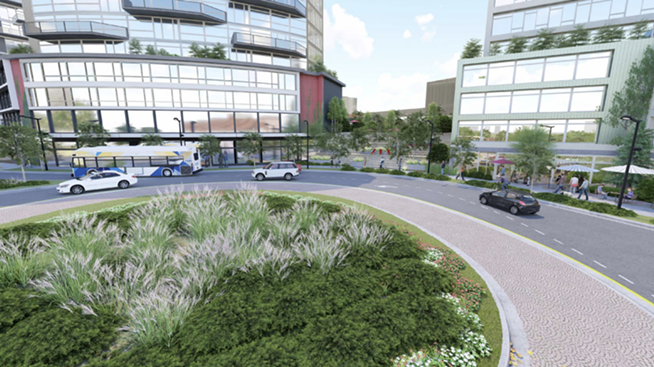
In a 2019 Coast op-ed, pedestrian safety advocate Martyn Williams called the district’s design an “opportunity missed.” The plan’s “roundabouts and wide roads” went against the promise of the 2014 Cogswell Lands Plan, he argued, which envisioned a “stark contrast” to the “exclusive automobile orientation” of the previous interchange—and laid forth a vision for a “walkable and transit oriented extension of the fine grained downtown of Halifax.”
Design consultants at Gehl agreed: In February 2019, the Copenhagen- and New York-based urban design firm drafted a report to the HRM that highlighted several “core challenges” with the Cogswell District’s initial design, including that it “prioritizes vehicles, not pedestrians/bike connections,” it didn’t “adequately show how pedestrians will be protected from heavy traffic” and it was “unclear” what the plan’s proposed public spaces were intended for.
The HRM went back to the drawing board and released a second draft of its Cogswell designs on Feb. 26, 2019, three weeks after receiving the Gehl report. But Williams argued that the newer plans “retain the look and feel” of the old ones—“a road network with some peripheral, indirect and sometimes traffic-marooned buildings and routes for residents, pedestrians and cyclists.”
Donna Davis, project manager for the Cogswell District, begs to differ. Speaking by phone with The Coast, she says the final design “is all about ensuring that we have really great public spaces, very wide sidewalks [and] great street furniture,” and mentions the district, when finished construction in 2026, will complete the region’s AAA cycling network.
Davis adds the district is designed with traffic-calming measures, including “very narrow” streets—and that while planners “are accommodating the vehicle traffic and trucks, they will be moving at urban street speeds like you see in the downtown now.”
Complaints of Cogswell District ignoring African Nova Scotian history and injustices
One of the foremost concerns clouding the future Cogswell District is how Halifax will reconcile with its past—and present.
In Displacing Blackness: Planning, Power and Race in 20th Century Halifax, Concordia associate professor Ted Rutland writes that the former Cogswell Interchange was part of a slum removal strategy—along with the displacement and demolition of Africville—that, at one time, Halifax city hall boasted of as “blight removal.”
Halifax displaced thousands of people—most of them working-class, and many of them Black—between 1958 and 1961 to make room for the Cogswell Interchange.
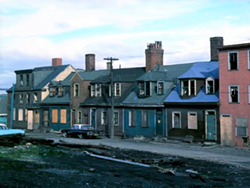
“It seems to me that if you recognize that, then your redevelopment plan would redirect those historical harms,” Rutland told The Coast in 2018. “You’d want to see housing for poor and working-class people. You’d want to make sure that some African Nova Scotian people get to live in those developments. You’d want to see public spaces that are shaped by the input of poor and working-class people.”
It was with the weight of this history that Marcus James, co-founder of 902 Man Up, a non-profit geared toward advancing Black communities in Nova Scotia, spoke at the Cogswell District plan’s unveiling in November 2021.
“It’s important that our voices are heard,” James told those gathered. “We’ve been here, as African Nova Scotian people, people of African ancestry, for over 400 years—and we want to be included.” He called the moment a “huge opportunity for us to turn a corner—to address some of those systemic barriers that we only know so well.”

Davis says there have been “significant conversations… going on for some time” with both the African Nova Scotian and Mi’kmaq communities in Halifax, and pointed to two components of the district’s plan. The HRM has set employment and supplier diversity targets that Dexter Construction is contractually obligated to meet, she says—“so we are working really, very closely with those community groups, with the constructor and with our team to look at how, over the next four years, we’re going to achieve those targets.”
Davis also mentions that Cogswell District’s new public spaces will provide an opportunity “for the histories and stories of underrepresented groups to be told,” and that she’s heard interest from both Mi’kmaq and African Nova Scotian communities in making use of those spaces—whether through public art, storytelling or other means.
Missed opportunity for affordable housing, advocates say
Top of mind for many Haligonians looking for a foothold in the region’s housing market is what provisions, if any, the HRM would make for affordable housing within the Cogswell District.
According to the Nova Scotia Association of Realtors, the average price of a Halifax or Dartmouth-area home in October was up 7.8% from the same time last year, to $517,000. As of Canada’s 2021 Census, more than 40% of Halifax households brought home less than $60,000 in income in a single year—and that includes 13.7% who brought home less than $30,000. By those numbers, it would take those latter one in eight Haligonians more than three years to afford a 20% downpayment on a home—and that’s only if, by sheer act of magic, they could squirrel away every single penny of their earnings.
Nova Scotia’s housing minister, John Lohr, described the province’s housing situation in March as having “reached a critical point.” A 2016 report said the waitlist for affordable housing in Halifax alone was around 1,300 people.
Housing advocates would like to see Halifax take strides to address that need with the Cogswell District—a neighbourhood the HRM expects will eventually serve as home to 2,500 people.
District 7 councillor Waye Mason has voiced his support for the notion. At a regional council meeting in January 2018, he told his colleagues that “we need to take more responsibility,” adding that the amount of affordable housing built in recent years “has plummeted to almost nothing.”
There are complicating factors. For one, social housing is funded, by and large, by the province—not the HRM. And while municipalities can require affordable housing as part of a development, that can deter would-be developers from signing onto a project if they don’t see a profit.
There’s a difference, in other words, for developers between building affordable housing on cheaper land compared to high-value real estate like the Cogswell District.
“The math would never work,” affordable housing developer Ron Lovett told The Coast in 2018. “I would never be able to service the debt, ever.”
That isn’t to say affordable housing is off the table. In 2018, then-HRM spokesperson Nick Ritcey told The Coast by email that decisions around affordable housing in the Cogswell District hadn’t been finalized, and that “it’s likely” that council may consider a density bonusing program with developers, “and/or the sale of municipally-owned lands” to create room and incentives for affordable housing.
Davis tells The Coast that HRM council “will be presented with a variety of options” as to how affordable housing could be incorporated into the project—and from there, the district’s planning team “will receive direction from them as to which option or options they want to employ.”
What’s next?
Construction of the Cogswell District is expected to take until 2026. The HRM is posting quarterly updates on its project website. The municipality has also launched a free app, for both Apple and Android, where you can find out the latest road closures and detours related to the project.

